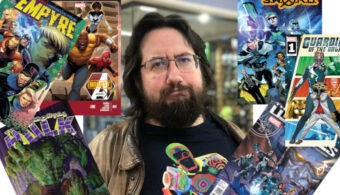David Michelinie was the writer of Amazing Spider-Man between 1987 and 1994, a fundamental period for the character, both from a narrative point of view (the marriage with Mary Jane and the birth of characters like Venom and Carnage), and from that of the artists involved (two names above all: Todd McFarlane and Erik Larsen). We asked the comic writer a few questions about what it meant to work at Marvel Comics in those years, on one of its leading characters.
 Hello David and welcome on Lo Spazio Bianco.
Hello David and welcome on Lo Spazio Bianco.
You lived through the golden age of the Spider, between the 80s and 90s of the last century, you wrote fundamental stories on Amazing Spider-Man illustrated by Todd McFarlane, Erik Larsen and Mark Bagley: what it meant to work at Marvel at that time, on main series of this character, together young illustrators who would later become the “disruptive” names of late twentieth century comics?
Marvel was a great place to work from the late 1970s to the late 1980s. Writers were appreciated, and there was a feeling of being a part of something important–and fun. I would occasionally pass Jim Shooter in the hall and he might ask me, “Are you happy? Are people treating you well?” Everyone seemed to be focused on making good stories and having a good time doing it.
How did you come to write Spider-Man and what was your first impact with the character?
I had been writing Avengers, Iron Man, and other Marvel titles when editor Jim Owsley offered me Web Of Spider-Man. Spider-Man was my favorite super hero character, so I jumped at the chance to write new Spider-Man adventures.
Which were the stories that most influenced you and your run on Spider-man?
I discovered Spider-Man around issue 63 or so of Amazing, and I was hooked forever. So Stan Lee’s original vision of Peter Parker and Spider-Man was what influenced me most. Though I also absorbed some of Gerry Conway’s version as well.
 You are the creator of Venom and Carnage, with the former becoming an icon of the contemporary Marvel Universe and the latter gaining more and more prominence in the last years: looking back at the ideas you had in mind when creating the character and comparing them with the path that they have done so far, what are your thoughts on this?
You are the creator of Venom and Carnage, with the former becoming an icon of the contemporary Marvel Universe and the latter gaining more and more prominence in the last years: looking back at the ideas you had in mind when creating the character and comparing them with the path that they have done so far, what are your thoughts on this?
When you stop writing a character you lose control over what that character does–unless you own it. I had a very simple, but strong, vision of who and what Venom was, and of his relationship to Spider-Man. Same was true of Carnage. But other writers have taken the characters far from those origins. I would not have put the Venom symbiote on someone else for a long time; to me Venom was Eddie Brock AND the symbiote. The symbiote and any other character just wouldn’t be “Venom”.
Would you have thought of something different for Eddie Brock and his symbiote?
If I had continued to develop the character I would definitely thought of many things to do with Eddie and the symbiote. That’s what keeps characters fresh. I might even have put the symbiote on another character–but only to demonstrate how that new combination would be totally different from the real “Venom”.
You are also the author responsible for the marriage between Peter and Mary Jane, a story that is still epochal as it is controversial, both for its genesis and for the aftermath it has left. What do you remember about the process and the idea that led to that decision?
Within days of accepting the writing assignment on Amazing Spider-Man, I was told that Stan Lee was going to get Peter and Mary Jane married in the newspaper comic strip–and that Marvel was going to follow suit in the comics. I hated it. I wanted to write the same character I had loved when I was a teenager: a young single guy with problems and courage, not an old married man. But Marvel was determined to get Peter and MJ married, so I decided to make the best of it and create a succesful married life for the couple, something that readers probably wouldn’t expect. And I surprised myself by having a great time writing Mr. & Mrs. Spider-Man!
 Do you think that marrying the two was the right choice or that it inevitably aged the character away from a young audience? Especially in light of the post One More Day and the creation of other teenage Spider-Man (Miles, Spider-Gwen), do you think Peter’s destiny is to crystallize as if he’s an Archie character?
Do you think that marrying the two was the right choice or that it inevitably aged the character away from a young audience? Especially in light of the post One More Day and the creation of other teenage Spider-Man (Miles, Spider-Gwen), do you think Peter’s destiny is to crystallize as if he’s an Archie character?
I think I did a pretty good job of keeping the young audience, since Amazing‘s sales rose steadily throughout my entire 5-year run. What happened after that, I can’t say since I stopped reading Spider-Man then.
Among the many collaborators that you had on the series, which is in your opinion the one that have better interpreted your scripts? And who was the one who surprised you the most with his work?
The answer to both of those questions is “Todd McFarlane”. He was the consummate professional, and followed my scripts as they were written. His artwork was also a breath of fresh air to the accepted graphic style, and that made it more fun for me to write dialogue to his pictures.
After Stan Lee, you are the author who has had the longest run on Amazing Spider-Man: what is your connection with this character?
(actually, I believe I’m #3 now; I’m pretty sure Dan Slott passed me to take the #2 spot–maybe even #1!) My connection is that I stopped reading comics when I was 14 and started again at 19 when I discovered Spider-Man. And that set me on my life’s work as a writer, primarily of comic books.
 What do you think is your most important legacy left to those who came after you (apart from the many new characters created by you)?
What do you think is your most important legacy left to those who came after you (apart from the many new characters created by you)?
I think the hundreds of comics featuring Venom and Carnage pretty much answer the question of my legacy to “those who came after”. As for the character itself and any legacy I may have with readers, I think I provided a few years of entertaining stories that showed respect for both the Spider-man character and the people who loved his adventures.
If you had to define Peter Parker and his alter ego after these many years, what would it be your answer?
I can’t speak for how the character is being handled these days. But when I was writing it I would define Peter Parker simply as…me. And you. And all the other everyday people reading the comics. That’s what Stan Lee introduced: the Every Man (or Every Kid) hero who’s just trying to rise above his daily problems to do the right thing.
Thanks for your time, David!
Interviewed by email in November 2021
David Michelinie
 David Michelinie (1948) is hired by Marvel in the seventies of the twentieth century and, in the same period, writes his first run on Iron Man together with Bob Layton, during which the author adds the vice of alcoholism to the character of Tony stark. Subsequently, the two return to the series, with Mark Bright at the pencils, creating the saga that later becomes known as the Armor War.
David Michelinie (1948) is hired by Marvel in the seventies of the twentieth century and, in the same period, writes his first run on Iron Man together with Bob Layton, during which the author adds the vice of alcoholism to the character of Tony stark. Subsequently, the two return to the series, with Mark Bright at the pencils, creating the saga that later becomes known as the Armor War.
After Iron Man Michelinie writes for a short time The Avengers, collaborating with John Byrne and George Pérez. He was then entrusted (assisted by the drawings of Todd McFarlane, Erik Larsen and Mark Bagley) with the series The Amazing Spider-Man, in which he introduced the symbionts and became the advocate of the marriage between Peter Parker and Mary Jane Watson.
After her work on Spider-Man, Michelinie moved to DC Comics, where for three years he wrote Superman stories in the pages of Action Comics. In 2001 he returned to writing with Bob Layton and Dick Giordano for Future Comics, until the publishing house went bankrupt in 2004. He returned to Marvel in 2008, again with Layton, writing the miniseries Iron Man: Legacy of Doom.





















